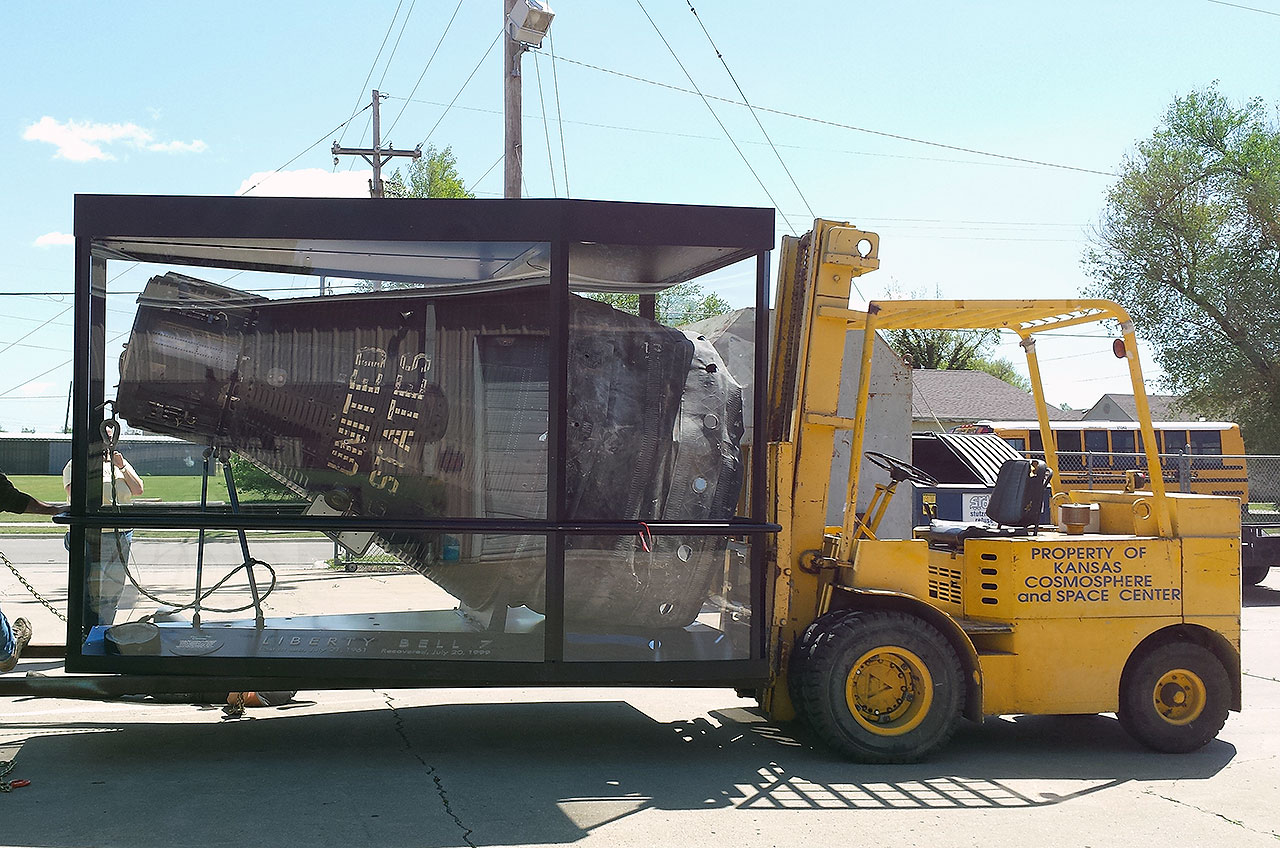Mercury Space Capsule Returns to Kansas After Overseas Art Exhibition

A historic U.S. spacecraft that launched the second American astronaut to space has landed back in Kansas after spending eight months overseas.
Liberty Bell 7, the Mercury capsule that NASA astronaut Virgil "Gus" Grissom flew on a 15-minute sub-orbital flight in 1961, returned to the Kansas Cosmosphere and Space Center in Hutchinson Monday (April 20). The small craft, which was barely large enough to seat its one pilot, was on temporary display in Bonn, Germany as part the exhibit "Outer Space: The Space Between Art and Science" that ran from October 2014 through late February of this year.
"She's back!" Cosmosphere officials wrote on Facebook, sharing photos of the capsule as it was offloaded from a truck and into the museum's SpaceWorks restoration and fabrication facility. "Liberty Bell 7 has safely returned from her voyage across the sea." [Project Mercury: NASA's 1st Spaceship in Photos]
The capsule did not fair nearly as well on its first time at sea. After splashing down from space on July 21, 1961, its hatch blew prematurely, resulting in the craft taking on water. Liberty Bell 7 sank 15,000 feet (4570 meters) to the floor of the Atlantic Ocean, where it remained for nearly 40 years until a Cosmosphere-led expedition raised it in 1999.
The Cosmosphere then restored the capsule, which under an agreement with the Smithsonian and NASA became its property. In 2000, the "The Lost Spacecraft" embarked on a six-year nationwide tour before landing on display at the Kansas museum.
The four-month exhibit at the Art and Exhibition Hall of the Federal Republic of Germany marked the first time that the Liberty Bell 7 had left the Cosmosphere since the end of "The Lost Spacecraft" traveling exhibition in 2006. The loan to "Outer Space" was also the first time the capsule had been displayed outside the United States.
Now back at its "home," conservators plan to inspect the spacecraft before installing it back on public display near the Cosmosphere's newly-renovated Justice Planetarium. Prior to leaving for Germany, Liberty Bell 7 had been on exhibit in the museum's Early Space Flight Gallery, along with the Gemini 10 spacecraft.
Get the Space.com Newsletter
Breaking space news, the latest updates on rocket launches, skywatching events and more!
Liberty Bell 7 will remain at the Kansas Cosmosphere until the end of the year, when it will again leave, this time for the Children's Museum of Indianapolis in Indiana. Though details about this next exhibition are still to be announced, it will mark a second visit for Liberty Bell 7. The Children's Museum was one of tour stops for "The Lost Spacecraft" from October 2000 through January 2001.
With Liberty Bell 7's return stateside, the 1969 Apollo 10 command module "Charlie Brown" is again the only NASA crewed spacecraft exhibited outside the United States.
Click through to collectSPACE.com for more photographs of the Liberty Bell 7.
Follow collectSPACE.com on Facebook and on Twitter at @collectSPACE. Copyright 2015 collectSPACE.com. All rights reserved.
Join our Space Forums to keep talking space on the latest missions, night sky and more! And if you have a news tip, correction or comment, let us know at: community@space.com.

Robert Pearlman is a space historian, journalist and the founder and editor of collectSPACE.com, a daily news publication and community devoted to space history with a particular focus on how and where space exploration intersects with pop culture. Pearlman is also a contributing writer for Space.com and co-author of "Space Stations: The Art, Science, and Reality of Working in Space” published by Smithsonian Books in 2018.In 2009, he was inducted into the U.S. Space Camp Hall of Fame in Huntsville, Alabama. In 2021, he was honored by the American Astronautical Society with the Ordway Award for Sustained Excellence in Spaceflight History. In 2023, the National Space Club Florida Committee recognized Pearlman with the Kolcum News and Communications Award for excellence in telling the space story along the Space Coast and throughout the world.










